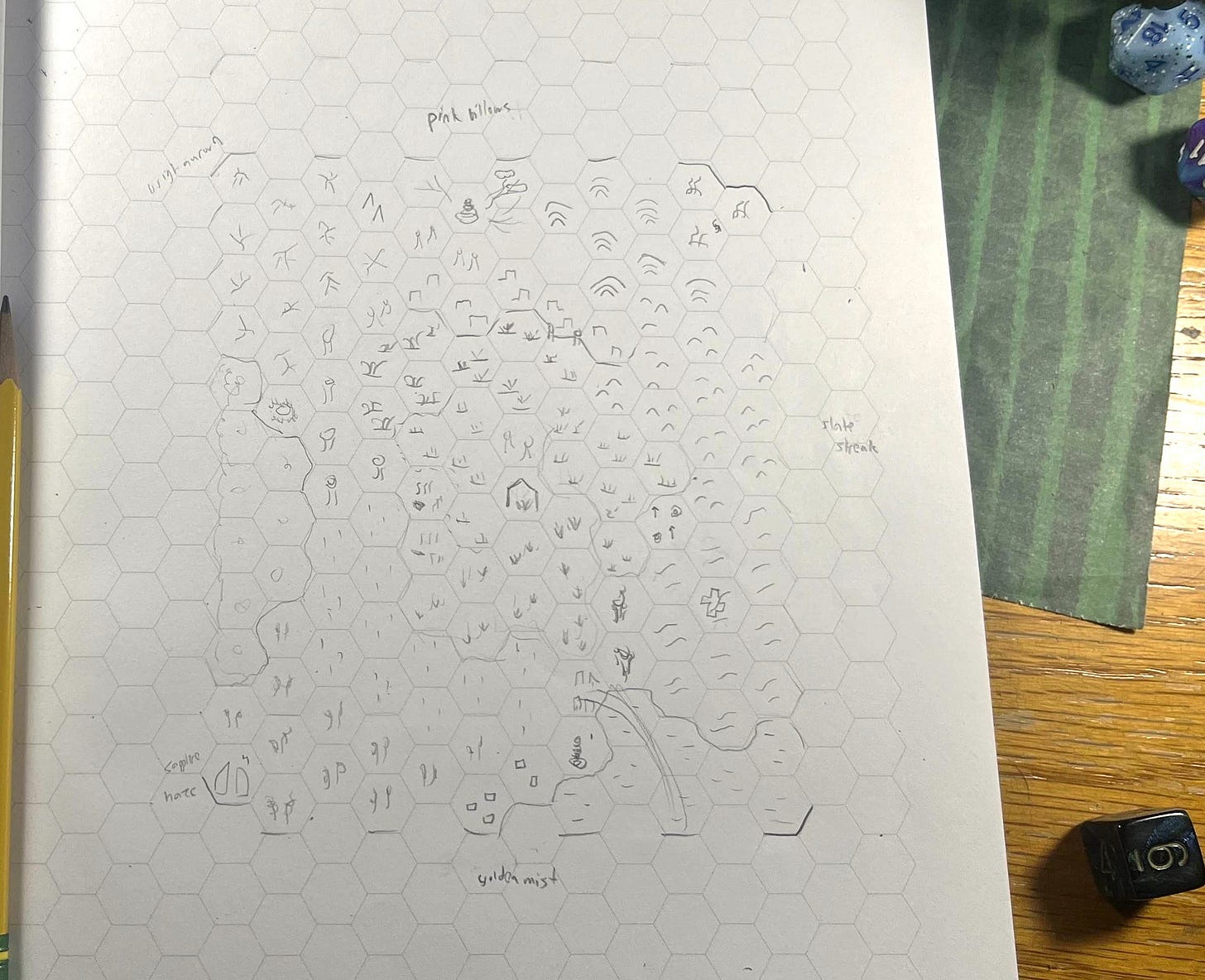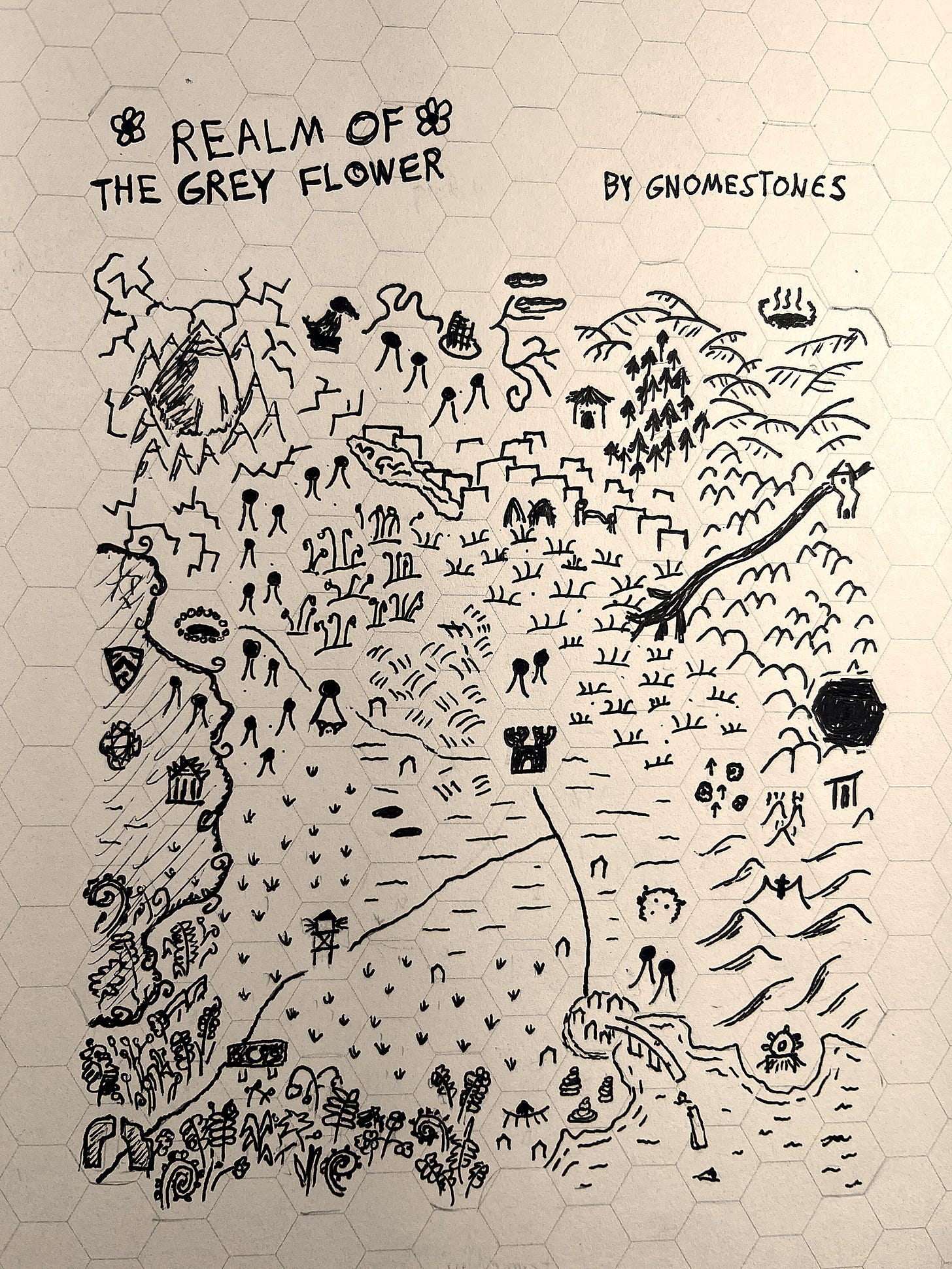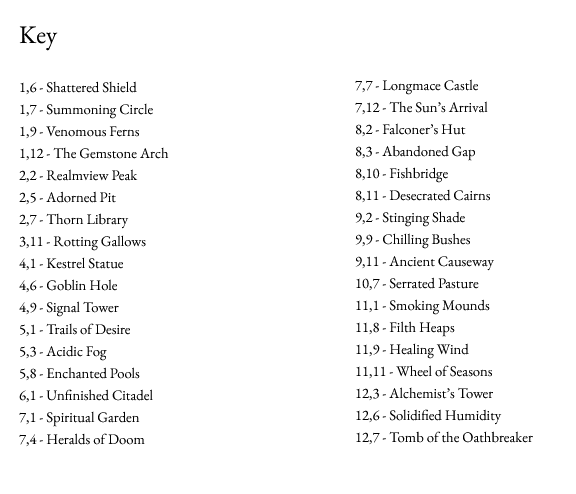Map-Making with Mythic Bastionland
Using new tools to make old worlds
Welcome back to the Gnomestones map lab, where we test out map creation tools and make some cartographantastic maps. In this session, we’re answering the question:
Can we make an immersive, playable, and fun map with only Mythic Bastionland tools, our trusty pen and paper, and the rest of the internet?
Mythic Bastionland is an excellent looking indie-TTRPG from the creator of Electric Bastionland, a beloved staple of the OSR/NSR genre. Mythic Bastionland takes the world of Bastion back to its mythical past, with lore inspired by British folklore and Arthurian legend. I haven’t played Electric Bastionland, so I’m not familiar with how the two rulesets compare, but we’ll focus solely on the Mythic Bastionland worldbuilding rules today. The early gnome gets eaten by the bird, so there’s no time to waste!
We’re going to start on page 14, ‘Creating a Realm’, and then move forward through the book, attempting to use the complete array of game resources. We’ll follow the dice as much as possible, and no take backs (minimum three take backs)! Here’s our hexbook.
Mythic Bastionland suggests a 12x12 hexgrid. Players are expected to travel two hexes by foot or four hexes on horseback per day in good conditions, so were likely using a scale of 6 miles per hex. 72 miles per side, a realm of more than 5000 sq. miles (apologies for my lack of metric).
The Creating a Realm page has instructions for wilderness, holdings, myths, and landmarks. We’ll start with wilderness, which takes us to the spark tables on page 22. When we made a map using Cairn2e rules, early faction creation had a positive impact on the narrative, so we may jump over to NPC sections at some point.
Interesting results! The sky and water sections are incredibly evocative. This may be typical for Bastionland aesthetics, but I noticed that almost all the sky and sea colors are abnormal. I’m also not sure the process for layering the water, land, and sky, do they occur in the same hex? I choose a flexible system where some hexes are fully occupied by water or land, and in other hexes land and water share.
I want to determine the seats of power, so I roll up four major holdings. I used a d6 method to randomize which subtables (pg. 26) applied for each holding.
Now I have more than enough to begin the imagining of the realm. I sketch out a border and then add the seat of power in a central location.
Moving to the knights and myths, a highly creative aspect of Mythic Bastionland. The d12 tables lead to six dozen knights and six dozen myths, and each come with compact storylines and feel deeply unique or magical. We roll six of each, as well as d12s for the coordinates of the myths’ hexes (pgs 26,27).
It works well to put the myths around the periphery of the map, serving as destinations and representing the ‘weird’. The four winds are written on the sides.
To round out our locations, we add landmarks and features. Landmarks come in six varieties, Dwellings, Sanctums, Monuments, Hazards, Curses, and Ruins. We chose landmarks by rolling on the myths tables and turning to the page with the corresponding myth, where the landmarks are listed at the bottom. We also rolled coordinates for the landmarks, and added six features from page 22 for good measure.
The instructions explain that landmarks could be discovered in the middle of gameplay, but we pick out our full roster ahead of time. At this point we have around 36 locations out of 144 hexes, 1 in 4 occupied. Grood! We start inking key locations while adding more to the periphery with pencil.
We’re almost there, but after counting up the hexes it was clear we needed a few more rolls to round out the landscape. We return to the land tables, and roll weather, flora, fauna, wonders, and otherworldly qualities (pg. 22).
This adds a few more locations. With some light math we can determine that if you generate your map using a d12 to choose the number of hexes per land type, it will most likely take 15-18 rolls to fill your map completely, not including locations.
After these rolls, we have enough to finish the map. Here’s the process in video form.
So that’s it! If we wanted to take this map and use it in a game, the next thing I’d do is determine the locations of the knights and animals, then roll for NPCs using the People tables on page 24.
If I were to make another map using these tools, I would want to focus more on a fiefdom-style map in which several knights and other leaders vie for power over shifting territory. I would also want find a way to convey a greater sense of topographic scale, because I think this one lacks a bit of ‘vastness’. I may also add the four winds in the future, but this is enough for now.
Without further ado-
WHEN THE SOUTH WIND rises as a golden mist over a sea of pearl and the north wind brings down grand pink billows through painted chasms, when the east wind drags iron rods across the hinterland sky and the west wind offers poisoned promises on vapor trails of teal and sapphire, then you will know that you stand in the Realm of the Grey Flower. Enter under the magnificent Gemstone Arch and admire the rangers as they protect you on the overgrown trail. Attend the Greyflower Court at Longmace Castle, visit the ancient city of Fishbridge (avoiding the minor rebellion), or brave the journey to our secluded Circular Citadel (still under construction). Enjoy the jousting of the brave and magnificent knights, who have arrived from all corners within and beyond the realm for this wonderful celebration of our new gracious leader, and do not dither in the slightest over the many troubling omens escalating in the shadows. I am honored to welcome you to the Realm of the Grey Flower!
The map and key are yours to use! Just remember to play the Gnomestones way.
And finally here is our review of Mythic Bastionland’s map-making features.
The Good, The Bad, and The Crunchy
The Good: The knight and myths are incredible and drive my desire in playing the game. There are excellent options on the charts for sea and sky and the landmarks play out in the fun fashion as well. I like the idea of holdings and seats of power underscoring the regional drama. Overall Mythic Bastionland does an excellent job of evoking a legendary and mystical feeling, and delivers on the things it intends to do.
The Bad: The hexbuilding procedures are a bit scattered throughout the text.The Creating a Realm page is helpful but I’d like it to be directly before the spark tables. It’s not entirely clear how the landmarks are generated. There’s not much else lacking, but I would like slightly more options in the land charts, maybe two different d12 tables or a d24.
The Crunchy: Hexmaps often create a blocky feeling for a landscape, so I went out of my way to draw features between the hexes in places where the terrain carried over. For a game, I would give the players a partially finished non-hexed version of the map for their own orienteering. Still, I would like more spaciousness for a 5000 square mile area, which might require more shading, more color, or a different icon system.
Until next time on Gnomestones.
















Welcome back to shoving the shoelaces under the tongue, welcome back to Gnomestones.